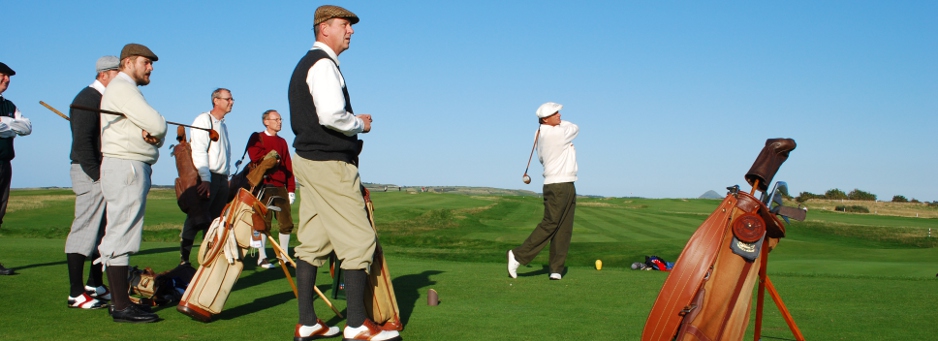Varför spela med Hickoryklubbor?
Man kan fråga sig varför någon med dagens utbud av moderna och förlåtande klubbor, vill spela golf med hickoryskaftade klubbor som tillverkats före 1930? Svaren är flera, men vissa av oss som spelar har ett genuint historiskt intresse, några i synnerhet f.d. tävlingsspelare söker nya utmaningar, en del har tröttnat på poängjagande, uthålande, bolletande och sega fyrbollar, andra på materialhysterin, där tillverkare vill påskina att spelegenskaper medföljer vid köp av nya klubbor. Att träna eller spela strategiskt ingår inte i konceptet och golf har även för många blivit en machosport som går ut på att slå långt, men inte rakt och absolut inte på fairway.
En gemensam nämnare är dock gemenskapen, många har saknat den genuina klassiska klubbkänslan, som de själva växte upp med. En ingrediens som tyvärr oftast är bortskalad i moderna klubbar, där stressade personer springer upp till 1:a tee, hastigt hälsar, klappar till med deLux-megadrivern, sprider och letar sen bollar i hela kommunen och hysteriskt hålar ut. Lika snabbt som de kom, lämnar de klubben med en rivstart.
Förutom att vi söker gemenskap och genuin klubbkänsla, så är det dessutom roligare eller snarare mycket roligare att spela med hickoryskaftade klubbor. När det gäller själva spelet ligger utmaningen bl a. i att spela med ett fåtal klubbor i bagen (oftast 6-8 st.), att använda samma klubba till en mängd olika slag. Man lär sig att forma slag. Och just att lära sig detta är hysteriskt roligt och oerhört utvecklande.
Man experimenterar och leker därför mycket mer för att forma olika slag vid varje hål. Man lär sig också spela strategiskt genom att det t ex. är svårt att få ”bite”, man siktar oftare mitt på green, än på pin. Man försöker också när läge finns, spela mellan bunkrar och använda t. ex. onduleringar för att just undvika att slå över i synnerhet bunkrar, som är svåra att behärska, eftersom en hickoryskaftad klubba ofta saknar en bred sula med bounce.
Att spela hickorygolf är i stort en livsstil, som bygger på gamla värdegrunder med bl a. snabbt spel, fair play, gemenskap, klubbkänsla, samt matchspel – att lira, ha kul och umgås på riktigt.
Såvida det inte är tävling, bryr vi oss alltså inte om det i Sverige “heliga” scorekortet, utan istället spelar vi spännande, kul och lustfylld golf i dess ursprungliga form, dvs. matchspel, gärna foursome. Trevligt sällskap, matchspel och gemenskap – det betyder något.
Eftersom hickory är ett valnötsträslag och ett mindre vridstyvt material än dagens grafit- och stålskaft, får man störst precision när man svingar mjukt och ”väntar in” klubbhuvudet. Man svingar därför klubbhuvudet i stället för att slå bollen.
Hickoryskaft kräver alltså att man lugnar ner svingen och lär sig behärskar fler typer av slag – med samma klubba.
När det gäller bollval, spelas hickorygolf med mjuka lågkompressions bollar.
I och med att man svingar lugnare och slår lite kortare, kommer också hindren i spel på ett annat sätt och man spelar oftast de äldre banorna som de enligt arkitekten var tänkta att spelas.
Det handlar om att söka – och finna! – spelets själ. En livsstil. Att spela golf på riktigt.
Copyright © Hickory & Linksland





